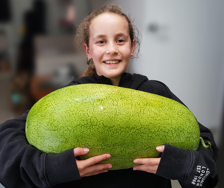Yates Account
Join now
Create a Yates account today!
Sign up to join the Yates Garden Club for monthly e-mails packed with seasonal inspiration, tips for success & exclusive promotions.
Plus if you’re a Garden Club member you can take part in the Yates Growing Community - a blog to share successes, get advice & win prizes in fun challenges along the way!

Forgot password
Enter the email address associated with your account, and we'll email you a new password.
Alternaria solani

What is Early Blight?
Early Blight (also known as Target Spot) is a fungal disease that most often affects tomatoes, potatoes, capsicums and eggplants. It can affect seedlings, but is most often seen on mature plants.
Early blight often occurs during humid weather. Plants suffering stress are at greater risk of being infected.

Symptoms
Tomatoes
On mature plants, black or dark brown spots with with a distinctive concentric ring pattern (hence the name 'target spot') develop on leaves. Older, lower leaves are affected first. In severe cases, leaves turn yellow, wither, then die off, leading to severe defoliation. Sometimes elongated brown marks (surrounded by a yellow halo) will appear on stems.
On seedlings, spots will develop on leaves and stems. Spots can grow to encircle stems, leading to die-off.
Infection reduces plant vigour, fruit yield and quality, and can cause plant death. On fruit, leathery black sunken spots usually develop around the stalk (calyx) first, before getting larger, often causing rotting on one side of the fruit. Fruit spots can have visible concentric rings, similar to the leaf spots.

Potatoes
Leathery-looking dark brown to black spots on the leaves, which become more angular as they develop. The spots are usually 6mm wide, but they can double in size under favourable conditions (high temperatures and high humidity). The spots also have the classic concentric ring pattern and if left untreated, can spread.
Potato tubers themselves usually aren't damaged, but the disease can severely impact yield.

How to Protect Your Plants
The disease is easier to prevent than treat: the fungus can be prevented from entering the plant by spraying with a film of protective fungicide, like Yates Liquid Copper. When you see symptoms, apply a fungicide immediately to stop the disease from spreading to your other plants.
Remove dead or damaged leaves and make sure there’s good air movement around the plant.
Fungal pathogens can persist on old material in the soil or on other 'host' plants, like nearby weeds, for up to a year. Destroy affected and neighbouring plants after harvest, by binning or burning them. Only save seed from disease-free plants, as the fungus can infect seeds.
Practice crop rotation. Ensure potato, tomato, capsicum and eggplant plantings never follow one another. Choose a different spot each year (avoid planting in the same part of the garden for at least 3 years). If you don't have enough space for this, consider growing tomatoes and potatoes in grow bags.
Water the soil and feed plants regularly to keep them growing well – healthy plants can better resist pests and diseases.
Plants Impacted
- Tomato
- Potato
- Capsicum
- Eggplant















Share
Share this article on social media